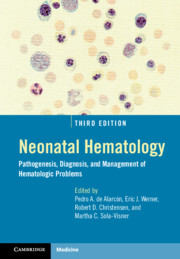Book contents
- Neonatal Hematology
- Neonatal Hematology
- Copyright page
- Contents
- Foreword
- Preface
- Contributors
- Section I Developmental Hematology
- Section II Bone Marrow Failure and Immune Disorders
- Section III Erythrocyte Disorders
- Chapter 6 Newborn Genetic Screening for Blood Disorders
- Chapter 7 A Guide to Identifying the Cause of Anemia in a Neonate
- Chapter 8 Anemia of Prematurity and Indications for Erythropoietin Therapy
- Chapter 9 Hemolytic Disease of the Fetus and Newborn
- Chapter 10 Neonatal Hemolysis
- Chapter 11 Polycythemia and Hyperviscosity in the Newborn
- Section IV Platelet Disorders
- Section V Leucocyte Disorders
- Section VI Hemostatic Disorders
- Section VII Neonatal Transfusion Medicine
- Section VIII Neonatal Oncology
- Section IX Miscellaneous
- Index
- Plate Section (PDF Only)
- References
Chapter 10 - Neonatal Hemolysis
from Section III - Erythrocyte Disorders
Published online by Cambridge University Press: 30 January 2021
- Neonatal Hematology
- Neonatal Hematology
- Copyright page
- Contents
- Foreword
- Preface
- Contributors
- Section I Developmental Hematology
- Section II Bone Marrow Failure and Immune Disorders
- Section III Erythrocyte Disorders
- Chapter 6 Newborn Genetic Screening for Blood Disorders
- Chapter 7 A Guide to Identifying the Cause of Anemia in a Neonate
- Chapter 8 Anemia of Prematurity and Indications for Erythropoietin Therapy
- Chapter 9 Hemolytic Disease of the Fetus and Newborn
- Chapter 10 Neonatal Hemolysis
- Chapter 11 Polycythemia and Hyperviscosity in the Newborn
- Section IV Platelet Disorders
- Section V Leucocyte Disorders
- Section VI Hemostatic Disorders
- Section VII Neonatal Transfusion Medicine
- Section VIII Neonatal Oncology
- Section IX Miscellaneous
- Index
- Plate Section (PDF Only)
- References
Summary
This chapter focuses on the recognition and management of hemolysis in newborn infants (). Some of the common hemolytic anemias of childhood first appear in the newborn period, while others do not present until several months of age, and a few rare hemolytic disorders occur only in the neonatal period. These variations in the age that hemolytic anemia first presents reflect differences in neonatal erythropoiesis, hemoglobin synthesis, and the metabolism of newborn erythrocytes. When approaching an infant with a potential hemolytic disorder, the first issue to be addressed is whether there is evidence of increased red-cell destruction and accelerated production. If yes, then the next question to consider is whether the cause of neonatal hemolysis is due to extracellular (acquired) factors or an intrinsic (genetic) red-cell defect. Acquired disorders are those that are immune mediated, associated with infection, or accompany some other underlying pathology. Inherited red-cell disorders are due to defects in the cell membrane, abnormalities in red blood cell (RBC) metabolism, or a consequence of a hemoglobin defect.
- Type
- Chapter
- Information
- Neonatal HematologyPathogenesis, Diagnosis, and Management of Hematologic Problems, pp. 155 - 184Publisher: Cambridge University PressPrint publication year: 2021



